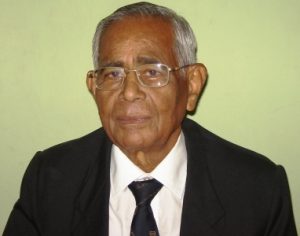 Dr. P. K. Jena in Bhubaneswar, August 26, 2022: India which falls in the water scarcity zone of the world is getting more and more affected by water scarcity due to quick increase of population along with rapid industrialization and urbanization.
Dr. P. K. Jena in Bhubaneswar, August 26, 2022: India which falls in the water scarcity zone of the world is getting more and more affected by water scarcity due to quick increase of population along with rapid industrialization and urbanization.
But, the availability of freshwater is diminishing rapidly. In the country the availability of water during the period 1951-2001 has declined from 5177 m3 to 1820 m3 per capita per year shown in following figure.
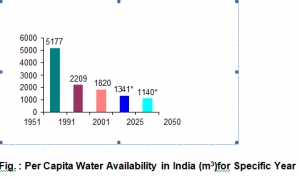
Due to shortage of fresh water, it is apprehended that, by the year 2050, the availability of freshwater per capita per year would further reduce to 1140 m3 unless appropriate majors are taken to increase urgently freshwater resources of the country.
In India, there is a large variation in rainfall during monsoon from very low rainfall (11mm) in Rajasthan in the west to very high (1200mm) in Cherapunji in the east with an average rainfall of 1200mm during the year. Except the main perennial rivers like the Ganges and the Brahmaputra, other rivers are comparatively much smaller and not perennial.
The freshwater available in surface sources of the country is estimated to be 1680 km3 which is mostly replenished every year through rain. Due to short period of rainy season in a year and large variation in rainfall in different parts of India, coping with annual floods and droughts both occurring at the same time in different parts of the country, has been a great concern of the nation.
The rapid increase of water demand in India in agricultural, industrial and domestic sectors has compelled the nation to look for alternate sources and one of these is transferring water from potentially water surplus Himalayan rivers to water scarce river basins of western and peninsular India. In view of this, the idea of National River Linking Project (NRLP) has come into picture.
National River Linking Project (NRLP):
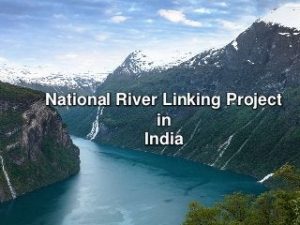 In India, the National River Linking Project (NRLP) formally known as the National Perspective Plan, envisages the transfer of water from water surplus basins where there is flooding to water-deficit basins where there is drought and scarcity, through inter-basin water transfer projects.
In India, the National River Linking Project (NRLP) formally known as the National Perspective Plan, envisages the transfer of water from water surplus basins where there is flooding to water-deficit basins where there is drought and scarcity, through inter-basin water transfer projects.
It is envisaged to build 30 river links and approximately 3000 storages to connect 37 Himalayan and peninsular rivers to form a gigantic water grid. In this massive and ambitious project, construction of over 1000 km of linked canals is proposed and 10000 MW of electricity for lifting 11000 cusecs of water is required. The cost of the project has been estimated to be around 5600 billion rupees.
1. Some of the main reasons in favour of interlinking the rivers in India are summarized below.
a) In order to equalize the effect of wide variations in rainfall in India (for example, 11mm in Rajasthan and 12000 mm in Assam where as 1200mm is the national average)
b) To utilize surplus and unused river flow in water deficit areas in southern and western India.
C) In order to control twin problems of flooding and drought in the basins.
d) To generate more irrigational facilities for about additional 40 million hectare of agricultural land.
e) Increasing food grain production for about 1.5 billion people by year 2050.
f) To produce hydro power at suitable places for generating about 35,000 MW of electricity and
g) Deriving additional benefits like flood control, navigation, water supply, fisheries, salinity control and pollution control.
2. Some major activities to be undertaken and problems faced in order to achieve the NRLP project.
(a) 173 billion cubic meter of water should be transferred from Rivers Brahmaputra and Ganges to southern and western parts of India through 30 links totalling to 14900 km long and 200 m wide.
(b) Himalayan links on the rivers Ganges and Brahmaputra and their tributaries are likely to affect mainly Bangladesh and North East Indian states.
(c) 16 peninsular links will affect mainly states situated in Central parts of India.
(d) 35 reservoirs on various rivers in India, Bhutan and Nepal are to be constructed.
(e) To effect the NRLP, nearly 2940 to 4000sq km of land has to be acquired.
(f) Nearly 5 lakhs people will be displaced for 16 peninsula links
In order to make this highly ambitious and costly project successful, a lot of information and critical analysis in each of the above areas by the experts are highly desirable. It is reported that, some strategic analyses of the NRLP of India have been carried out by the experts.
3. Some Major Obstacles for Implementation of NRLP are as follows:
a. There are International and inter states disputes regarding their shares of water of the concerned rivers.
b. High cost (approx 6000 billion rupees) involved for implementing the project.
c. Insufficient data like actual stream flow and water availability based on rainfall runoff relations are available.
d. Lack of sufficient data on the success of similar projects in other parts of world
e. Diversion of flood water would be a big problem. It is apprehended that, even a series of dams in northern rivers during monsoons cannot bring the flow under control.
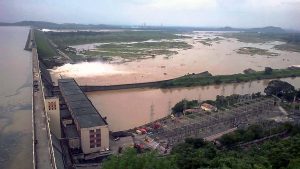 f. Apathy exists against construction of big dams all over the world mainly for adverse social and environmental impacts. Large dam is legally prohibited in some developed countries like Sweden and USA.
f. Apathy exists against construction of big dams all over the world mainly for adverse social and environmental impacts. Large dam is legally prohibited in some developed countries like Sweden and USA.
g. NRLP would result in distribution of pollution throughout the water bodies and making it impossible for undertaking pollution control majors.
h. The NRLP is timely to result in a lot of geographical and other related disturbances in huge areas of the country
i. The project has to solve gigantic problems for rehabilitation of large number of affected families and
j. Time to time drazing of about 15000 km long and 200m wide canal areas connecting the rivers would be another huge recurring expenditure in the project.
The gigantic plan of linking of all the rivers in North and South does not seem to be a wise proposal at this stage particularly because of lack of enough technologies, high cost, and environmental impacts and more over to avoid interstates as well as international conflicts.
It is worthwhile to undertake at present alternate measures for solving our water crisis.
Some of the promising programmes to solve water crisis in the country are given below.
(a) Rain water harvesting on the surface as well as recharging the aquifer on a massive scale both in rural and urban areas.
(b) As in India more than 70% of freshwater is being used in irrigation, the irrigation system should be more modernized for economic use of water.
(c) Various measures to be undertaken to reduce water consumption in urban and industrial areas.
(d) The urban wastes and sewage effluents should be treated suitably before letting out these to the water bodies.
(e) Prevention of wastage of water in various sectors particularly during transportation of water.
(f) Large scale rain water harvesting and recharging of the aquifers both in rural and urban areas and its utilization mostly for domestic purposes.
(g) Development of existing wetlands and creation of new ones, facilitating rainwater harvesting and recharging the groundwater.
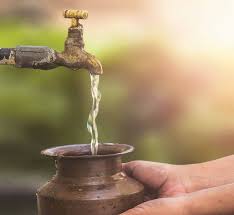
(h) Pricing of water is necessary and the tariff should be fixed in proportion to the benefits derived by the consuming agencies
(i) Undertaking massive plantation programmes on the embankments of the rivers.
(j) Water harvesting in large number of mine pits available in the mineral rich areas of the country.
(k) Industries should be motivated to have their captive water harvesting units and to treat the used water for recycling.
The above programmes should be taken up urgently with full participation of concerned government organizations and local people. At the appropriate time in future a sober beginning can be made for linking rivers in one state or at best in two to three concerned states in the country. The experience in such programs will certainly help in deciding to undertake bigger programs like interlinking a perennial river of North with a non perennial one of the South.
• Former Director General, Council of Scientific & Industrial Research, India


Leave a Reply
Be the First to Comment!